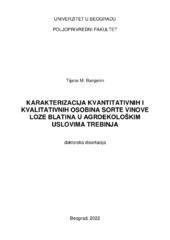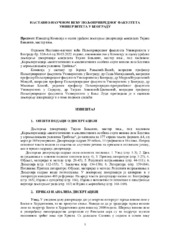Приказ основних података о дисертацији
Karakterizacija kvantitativnih i kvalitativnih osobina sorte vinove loze Blatina u agroekološkim uslovima Trebinja
Characterization of quantitative and qualitative characteristics of Blatina vine variety in agroecological conditions of Trebinje
| dc.contributor.advisor | Ranković-Vasić, Zorica | |
| dc.contributor.other | Matijašević, Saša | |
| dc.contributor.other | Vujadinović Mandić, Mirjam | |
| dc.contributor.other | Blesić, Milenko | |
| dc.contributor.other | Jovanović-Cvetković, Tatjana | |
| dc.creator | Banjanin, Tijana | |
| dc.date.accessioned | 2022-12-08T20:35:54Z | |
| dc.date.available | 2022-12-08T20:35:54Z | |
| dc.date.issued | 2022-07-22 | |
| dc.identifier.uri | https://eteze.bg.ac.rs/application/showtheses?thesesId=8852 | |
| dc.identifier.uri | https://fedorabg.bg.ac.rs/fedora/get/o:27110/bdef:Content/download | |
| dc.identifier.uri | https://plus.cobiss.net/cobiss/sr/sr/bib/81799433 | |
| dc.identifier.uri | https://nardus.mpn.gov.rs/handle/123456789/21037 | |
| dc.description.abstract | Predmet istraživanja u ovoj doktorskoj disertaciji je autohtona sorta vinove loze Blatina gajena u agroekološkim uslovima lokaliteta Trebinje. Specifičnosti lokaliteta su definisane kroz analizu klimatskih karakteristika dva višegodišnja perioda (1971-1990; 2000-2019), analizu najvažnijih bioklimatskih indeksa, kao i analizu meteoroloških činilaca, mehaničkog sastava i hemijskih osobina zemljišta u godinama istraživanja (2016-2018). Program ove doktorske disertacije obuhvata tri pravca. Prvi pravac se odnosi na uticaj specifičnosti lokaliteta kao elemenata terroir-a na uslove gajenja, rodni potencijal i kvalitativne karakteristike autohtone sorte vinove loze Blatina. U sklopu drugog pravca urađena je karakterizacija i vrednovanje kvantitativnih i kvalitativnih osobina sorte Blatina, dok je u sklopu trećeg pravca urađena uporedna analiza agrobioloških i privredno-tehnoloških osobina sorte Blatina u poređenju sa sortama Vranac, Merlo i Kaberne sovinjon koje su takođe gajene na lokalitetu Trebine. Klima vinograda se na području lokaliteta Trebinje posljednjih pedeset godina (1971-2019) promjenila. Analizirajući podatke za posmatrane klimatološke periode (1971-1990 i 2000-2019) utvrđeno je povećanje srednje godišnje temperature vazduha za 2°C i srednje vegetacione temperature vazduha za 2,4°C. U periodu 2000-2019. godina došlo je do povećanja normalne godišnje količine padavina za 6% i smanjenja normalne vegetacijske sume padavina za 4,6% u odnosu na klimatološki period 1971-1990. Između dva posmatrana klimatološka perioda, prosječni početak vegetacionog perioda se pomjerio za 15 dana ka početku godine, dok se prosječno njegov kraj pomjerio za 9 dana ka kraju godine. To je dovelo do povećanja prosječne dužine vegetacije od 23,7 dana. Uočena je promjena vrijednosti bioklimatskih indeksa (WI, CI, HI, DI i NTX35). Sve ove promjene su imale uticaja i na kvalitet proizvedenog grožđa i vina kod ispitivanih sorti. Godina je imala veoma značajan uticaj na broj razvijenih i rodnih lastara, koeficijente relativne i apsolutne rodnosti, dužinu i širinu grozda, broj bobica u grozdu, masu 100 bobica, masu mezorkapa u 100 bobica i masu šepurine sorte Blatina. Hemijskom analizom utvrđeno je smanjenje vrijednosti parametra fenolnog sastava pokožice usljed negativnog dejstva visokih temperatura (NTX35 = 23 dana) tokom 2017. godine. Od 13 izmjerenih, utvrđeno je opadanje vrijednosti 12 pokazatelja fenolnog sastava pokožice sorte Blatina, 11 pokazatelja kod sorte Kaberne sovinjon, 9 pokazatelja kod sorte Merlo i 8 kod sorte Vranac. Rezultati hemijske i senzorne analize vina ukazali su na značajan uticaj meteoroloških činilaca na kvalitet vina. U vinu sorte Blatina kod 12 od identifikovanih 17 pokazatelja fenolnog sastava se bilježe vrijednosti manje 2017. nego 2016. godine. U pogledu fenofaza proučavanih sorti uočeno je variranje u zavisnosti od sorte i godine istraživanja. Najveće variranje rodnosti okaca i prinosa grožđa ispoljile su sorte Blatina i Vranac. Parametri kvaliteta sjemena i listova značajno su varirali u zavisnosti od sorte vinove loze. Analizom je utvrđeno da sorta Blatina ima listove sa najvećim sadržajem ulja, proteina, karotenoida i ukupnih fenola. Autohtona sorta vinove loze Blatina gajena na lokalitetu Trebinje ispoljila je niz specifičnosti u pogledu hemijskih i bioaktivnih svojstava pokožice, mineralnog sastava sjemenki i listova, kao i fenolnog sastava vina. Rezultati ove disertacije mogu biti korisni u sagledavanju i savladavanju izazova klimatskih promjena i pomoći u odabiru odgovarajuće enološke prakse. | sr |
| dc.description.abstract | The subject of research in this doctoral dissertation is the autochthonous grape variety Blatina grown in agroecological conditions of the Trebinje. Locality specifics are defined through the analysis of climatic characteristics of two multi-year periods (1971-1990; 2000-2019), analysis of the most important bioclimatic indices, as well as analysis of meteorological factors, mechanical composition and chemical properties of the soil in research years (2016-2018). The program of this doctoral dissertation includes three directions. The first direction refers to the influence of the specificity of the locality as an element of terroir on the growing conditions, yield potential and qualitative characteristics of the autochthonous grapevine variety Blatina. Within the second direction, the characterization and evaluation of quantitative and qualitative characteristics of the Blatina variety was done, while within the third direction, a comparative analysis of agrobiological and economic-technological characteristics of the Blatina variety was made compared to Vranac, Merlot and Cabernet Sauvignon varieties also grown in Trebinje. The climate of vineyards in the area of Trebinje locality has changed in the last fifty years (1971-2019). Analyzing the data for the observed climatological periods (1971-1990 and 2000-2019), the increase of the average annual air temperature by 2°C and the average vegetation air temperature by 2.4°C was determined. In the period 2000-2019 year there was an increase in the normal annual precipitation by 6% and a decrease in the normal vegetation amount of precipitation by 4.6% compared to the climatic period 1971-1990. Between the two observed climatological periods, the average beginning of the vegetation period shifted by 15 days towards the beginning of the year, while on average its end shifted by 9 days towards the end of the year. This led to an increase in the average vegetation period length of 23.7 days. A change in the values of bioclimatic indices (WI, CI, HI, DI and NTX35) was observed. All these changes had an impact on the quality of grapes and wine produced in the tested varieties. The year had a very significant impact on the number of developed and native shoots, coefficients of relative and absolute fertility, length and width of the bunch, number of berries in the bunch, weight of 100 berries, weight of mesorcaps in 100 berries and weight of peduncle of Blatina variety. Chemical analysis revealed a decrease in the value of the parameters of the phenolic composition of the epidermis due to the negative effects of high temperatures (NTX35 = 23 days) during 2017. Of the 13 measured, a decrease in the value of 12 indicators of the phenolic composition of the skin of the Blatina variety, 11 indicators in the Cabernet Sauvignon variety, 9 indicators in the Merlo variety and 8 in the Vranac variety was found. The results of chemical and sensory analysis of wine indicated a significant influence of meteorological factors on wine quality. In the wine of the Blatina variety, 12 of the identified 17 indicators of phenolic composition recorded lower values in 2017 than in 2016. Regarding the phenophases of the studied varieties, variation was observed depending on the variety and the year of research. The varieties Blatina and Vranac showed the greatest variation in bud fertility and grape yield. Seed and leaves quality parameters varied significantly depending on the grape variety. The analysis determined that the Blatina variety has leaves with the highest content of oil, protein, carotenoids and total phenols. The autochthonous grape variety Blatina grown on the locality of Trebinje showed a number of specifics in terms of chemical and bioactive properties of the skin, mineral composition of seeds and leaves, as well as the phenolic composition of wine. The results of this dissertation can be useful in understanding and overcoming the challenges of climate change and help in selecting appropriate oenological practices. | en |
| dc.format | application/pdf | |
| dc.language | sr | |
| dc.publisher | Универзитет у Београду, Пољопривредни факултет | sr |
| dc.rights | openAccess | en |
| dc.rights.uri | https://creativecommons.org/licenses/by-nc-nd/4.0/ | |
| dc.source | Универзитет у Београду | sr |
| dc.subject | Vitis vinifera | sr |
| dc.subject | Vitis vinifera | en |
| dc.subject | variety | en |
| dc.subject | chemical composition of grape | en |
| dc.subject | leaves and wine | en |
| dc.subject | phenolic compounds | en |
| dc.subject | bioclimatic indices | en |
| dc.subject | sorta | sr |
| dc.subject | hemijski sastav grožđa | sr |
| dc.subject | listova i vina | sr |
| dc.subject | fenolna jedinjenja | sr |
| dc.subject | bioklimatski indeksi | sr |
| dc.title | Karakterizacija kvantitativnih i kvalitativnih osobina sorte vinove loze Blatina u agroekološkim uslovima Trebinja | sr |
| dc.title.alternative | Characterization of quantitative and qualitative characteristics of Blatina vine variety in agroecological conditions of Trebinje | en |
| dc.type | doctoralThesis | |
| dc.rights.license | BY-NC-ND | |
| dc.identifier.fulltext | http://nardus.mpn.gov.rs/bitstream/id/148626/Disertacija_12955.pdf | |
| dc.identifier.fulltext | http://nardus.mpn.gov.rs/bitstream/id/152579/Referat.pdf | |
| dc.identifier.rcub | https://hdl.handle.net/21.15107/rcub_nardus_21037 |



